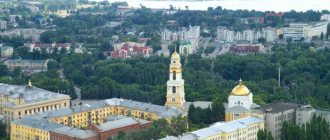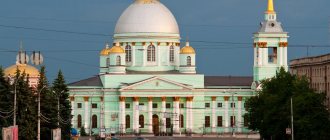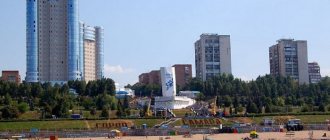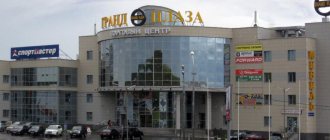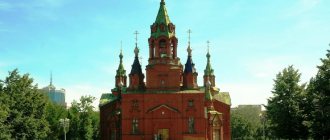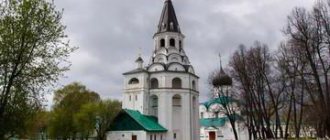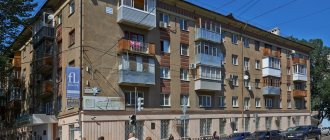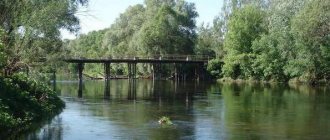On the border with the countries of the former Soviet Union, Belarus and Ukraine, is the city of Bryansk, whose population is very proud of its place of residence. And not without reason, because this settlement has a centuries-old and very fascinating history. In addition, the city often appears in fairy tales about Nightingale the Robber, a monument to which local authorities have been planning to erect for a very long time. This glorious and cozy city is mentioned in many chronicles, but only a few know its history, and especially the history of its inhabitants. This and much more will be discussed in the article.
History of the emergence and development of the city
The first data about the city dates back to the first millennium. Archaeologists have even found traces of the very first settlement. In addition, in many chronicles, Bryansk acts as a kind of “green shield” for its residents. For example, during the Tatar-Mongol invasion, the city’s residents were not harmed precisely because the enemies were frightened by the impenetrability of the forests surrounding the settlement.
The first ruler of the city was Prince Roman, the son of the appanage Prince Mikhail. Under the rule of this man, Bryansk became significantly richer, because Roman Bryansky had a good grasp of trade affairs. Moreover, the purchase and sale was carried out precisely with the West, where they exported honey, wax, fur, and received silk, soap and a wide variety of jewelry from there. The favorable location allowed Bryansk to feel confident in trade.
Peter I also visited this city. Thanks to his decree, the shipbuilding industry was launched. Many places in the city were noted by Peter I, and various legends on this topic are still passed down to subsequent generations.
Since the eighteenth century, industry began to flourish in this city, various plants and factories were built, and a wide variety of objects and things were produced. Today, much has been preserved from those times, but even more buildings and industrial facilities have been rebuilt or restored.
Coat of arms
The coat of arms of Bryansk is presented in the form of a French shield. At the top there is a red field, at the bottom there is a green field. The latter depicts a golden mortar with pyramids of cannonballs on both sides of the weapon. The left one (just above the mortar) has six large charges, the right one (at the carriage level) has 10 small ones. There are 5 golden elements on the green field. They symbolize plant shoots, rebirth and prosperity.
The ratio of the top of the shield to the bottom is 2:1. It is allowed to border the heraldry with a gold frame around the perimeter of the shield.
The coat of arms was approved on December 23, 2009 by Decision of the Bryansk City Council of People's Deputies No. 222.
Unusual data on the history of the city
The name of Bryansk used to be somewhat different. It contained the prefix “de” - D’bryansk. Many people believe that this name implied the location of the city among impassable forests. In reality, everything is somewhat different. Today it is known that in Old Slavonic sources the word “Dybr” meant “mountain slope, gorge.”
The following fact is also interesting: between the celebration of the 838th anniversary of the city’s founding and its thousandth birthday, only one calendar year passed. This curious feature and an amazing coincidence of circumstances are explained by the results of excavations, during which archaeologists were able to establish the real age of the city.
During the Great Patriotic War, Bryansk was simply a center of partisan brigades. About forty thousand people took part in this dangerous task.
Andrei Kartapolov and Vladimir Zhirinovsky will come to Bryansk for City Day
Deputy Minister of Defense of Russia, Head of the Main Military-Political Directorate of the Armed Forces, Colonel General Andrei Kartapolov will arrive in Bryansk to celebrate City Day. BryanskToday learned about this.
Andrey Kartapolov will take part in the celebrations marking the 75th anniversary of the liberation of the city from the Nazi invaders. This year, Bryansk will host festive events of unprecedented scale.
The decoration of City Day will be a parade of military equipment, in which T-72 tanks, BMP-2 tanks, artillery rocket launchers, and armored personnel carriers will take part. The column of equipment will be led by the legendary T-34 tank.
Let us remind you that this coming Monday, September 17, Bryansk will celebrate City Day, the 75th anniversary of liberation from the Nazis. Many high-ranking guests will come to the celebration.
Among them will be the leader of the LDPR, Vladimir Zhirinovsky. The Bryanskaya Street website reports this with reference to its sources. It is likely that he will take part in the parade.
Vladimir Zhirinovsky will also talk to the townspeople.
Climatic features of the city
Compared to many large settlements, Bryansk has a clear division into seasons in terms of climate. In addition, the air here is so clean and fresh that residents of other cities are very surprised when they arrive in Bryansk. And all this despite the fact that industry is well developed in Bryansk. This settlement is the center of various sanatoriums and recreation centers in the region. The reason for this is the wooded area.
The population of Bryansk districts with children strives to be closer to the Volodarsky district. This area of the city is considered the cleanest. There is less exhaust gas here. The only negative is the close proximity to the city dump. The city authorities have been thinking about building a waste treatment plant for a long time, but this issue still remains unresolved.
The weather here is changeable: although summer and winter keep their boundaries quite clearly, thunderstorms often occur in the spring and it can be windy. And yet, Bryansk is still popular, whose population loves their city for its cleanliness and freshness.
Infrastructure of the settlement
The city is predominantly filled with buildings from the Khrushchev era. In some places in Bryansk there are also “Stalin” cars. Simultaneously with the existence of rather old residential complexes, new villages are being built, and the population of the city of Bryansk is quite successfully building private houses.
As you know, today, on the site of the old airport, construction of an impressive microdistrict has begun, this facility is called the Priozerny village. In all respects, this is an excellent housing option - in the immediate vicinity there are shops and all the necessary service points. In addition, in terms of picturesqueness, this site surpasses most of the already existing residential complexes in a city like Bryansk (the population is trying to buy housing there now).
Where to go in Bryansk on September 17, 2021
11.00 — Parade of troops and military equipment “We are the country’s army! We are the army of the people!”
Where: Lenin Square - Partizan Square
12.30 — Parade of Generations
Where: Lenin Avenue
13.00 – Rally “Bryansk Street leads us to victory!”
Where: Partizan Square
14.00 — Concert of the military exemplary orchestra “Let’s sing, friends together!” Demonstration performances of the honor guard company.
Where: Partizan Square
14.00 — Exhibition of military equipment
Where: Krasnoarmeyskaya street
15.00 — Festival of national creativity “Real Russia”. Performance by creative groups from Bryansk, Volgograd, Gomel, Mogilev
Where: Partizan Square
13.00 — Concert of the Bryansk City Pop Orchestra “To you, dear fellow countrymen!”
Where: Theater Square
13.30 — Festival of brass bands “On Bryanskaya Street with an orchestra”
Where: Slavyanskaya Square
17.00 — Historical reconstruction “For the Motherland! For my native city!
Where: old airport
14.30 — Concert from creative groups of the city “To you, beloved city!”
15.20 — Concert of the author of the “Afghan song” Valery Petryaev
16.00 — Concert of performers of the patriotic song “Katyusha”
17.30 — Concert of the song and dance ensemble of the Western Military District
18.30 — Concert of soloists of creative groups of the Bryansk region, accompanied by the governor’s symphony orchestra “Songs of Victory”
20.00 — Concert of singer Alexander Dobronravov
20.30- Concert of ethno-pop singer Varvara
Where: Main stage, park named after the 1000th anniversary of Bryansk
21.30 — Artillery salute and festive fireworks
Where: territory of the old airport, Mound of Immortality
Transport issue
Private cars have already become an integral part of any city. Despite the roads not being of the best quality, more and more private transport appears in Bryansk every year. The authorities promise to improve the situation with the road surface, but this problem still appears on the list of major ones.
There are sometimes traffic jams in the city. As, in principle, in any other large populated area. Peak hours occur mainly in the morning and evening.
Public transport is very developed. Minibus taxis and buses can easily transport any citizen who does not yet have their own car. The frequency of public transport is very high; most people have to wait for the bus during traffic jams.
In addition, Bryansk is a large railway junction. There are three stations in the city, from which you can go to almost any locality. There is also an international airport in Bryansk.
The city of Bryansk: people and numbers
The year 2018 is significant for the Bryansk region with the celebration of the 75th anniversary of liberation from the Nazi invaders.
Today, 424 thousand people live in the regional center - 35% of the population of the Bryansk region. On average, there are 2,271 people per square kilometer of urban area.
The average age of a resident of Bryansk is 41.5 years (women – 44.2 years, men – 38.3 years).
As of January 1, 2021, 235.2 thousand women lived in Bryansk, i.e. more than half of the city’s population (55.5%) were representatives of the fair sex. The disproportion between the numbers of the “weak” and “strong” sex has led to the fact that there are 1,246 women per 1,000 men, although more boys are always born than girls. So it was last year that 2,397 boys and 2,226 girls were born. More than 67 thousand children live in the regional center under the age of 15.
At the end of 2021, 110 preschool educational organizations were attended by 25,371 children, of which 12,216 were girls, 4,497 children aged 1-2 years.
More than 48 thousand schoolchildren study in 72 general education organizations in the city.
There are 3,029 doctors and 7,122 paramedical personnel protecting the health of city residents. Health care services are available in 19 hospital institutions with almost 6 thousand hospital beds, as well as in 58 outpatient clinics with a capacity of 14.9 thousand visits per shift.
The basis of a healthy lifestyle is exercise. Currently, there are 477 sports facilities in Bryansk, including: 2 ice palaces, 6 stadiums with stands, 21 swimming pools, a ski slope in the Sovetsky district, a tennis center in the Bezhitsky district of Bryansk. About 8 thousand young athletes are involved in 13 children's and youth sports schools.
Cultural and art institutions are ready to welcome residents and guests of Bryansk. Among them are a circus, two theaters, and 12 cultural and leisure institutions. In 2021, 372.1 thousand people visited 5 museums in the city. There are 31 public libraries for book lovers.
Bryansk is a large industrial center. The city's industry has demonstrated steady growth rates over the years. The volume of shipped goods of own production, work and services performed by large and medium-sized manufacturing organizations in the first half of this year amounted to 38.1 billion rubles, which is 4.4% more than in the corresponding period of 2021.
Construction of new housing continues in the city. In the six months of 2021, residential buildings with a total area of more than 9 thousand m2 were put into operation. The average size of apartments built in the first half of 2021 is larger than in 2021 (87 m2 of total area versus 58 m2).
By the end of 2021, the housing stock of Bryansk amounted to 12,370.8 thousand m2. There were 29.2 m2 of total residential area per citizen.
Material provided by the BRYANSKSTAT press service, photo Pravda32.
What is the connection between Chernobyl and Bryansk?
Few people know what happened in the city after the Chernobyl disaster. For a long time, authorities informed citizens that the radiation cloud had passed by Bryansk and the region. But the events immediately after the incident leave no doubt: all the people who were trying to travel towards Kaluga at that time had their gifts taken away, their cars were thoroughly washed several times, and they very meticulously inquired about where exactly and for what purpose the citizen was going.
Given the lack of trust in local city clocks equipped with a dosimeter, it is unknown whether background radiation is high in a populated area. This is the reason for constant recommendations to the local population to undergo fluorography of the thyroid gland annually.
District division of the city
The central area is the Sovetsky district. From it in the north is the Bezhitsky district, in the southeast - Fokinsky, and in the east - Volodarsky. All of them are presented as separate territories. For example, the Sovetsky district is separated from Volodarsky by the Desna River.
The population of Bryansk is predominantly concentrated in the center. Despite the proven cleanliness of Volodarka (as residents of the Volodarsky district call it), everyone is trying to be closer to the central part of the city.
Residents of the Volodarsky district, as mentioned above, enjoy the fresh air. What can Bezhitsa district boast of? Although the city of Bryansk has existed for a long time, the population of this area still calls themselves living in Bezhitsa. This was the name of the city that once became part of Bryansk.
And the population of the Fokinsky district of Bryansk can boast of the following: this particular area contains an unusual place for recreation - an artificial lake. In addition, this area used to be a leading area in terms of railway traffic.
City information
Bryansk is located in the western part of Russia and is the administrative center of the region of the same name. Located on the banks of the Desna River.
The economy is represented by enterprises of heavy engineering, metalworking, chemical, electrical, and woodworking industries.
Federal highways pass through the settlement: M3, M13, A141. Large railway junctions operate. There are universities and their branches, secondary specialized educational institutions, and sports schools. There are cultural institutions: theaters, museums, concert halls. The population exceeds 400 thousand people.
Number of citizens of Bryansk
Today the population of the city of Bryansk is approximately 408 thousand people. This figure reached its maximum value by 1998 – 463 thousand people. Before this, there was a slight decrease in the number of residents.
The period from 1970 to 1989 distinguished itself in terms of growth. It was at this time that the population of Bryansk increased by 130 thousand. Then, until 2002, the number of people dropped quite rapidly by 21 thousand. After another decline, a period of stability began, which, however, did not last very long.
If we consider the population of Bryansk by district, the most popular is the Bezhitsky district. It is home to 152 thousand people. Next comes the Sovetsky district. Its population is almost 107 thousand people. Volodarsky and Fokinsky districts are almost identical in terms of the number of residents - 75 and 72 thousand people, respectively.
The situation with jobs in the city is quite difficult. The employment center (Bryansk) cannot provide all the unemployed with decent positions, and prices in stores do not lag behind those in the capital. Except that locally produced goods are not so expensive. Nevertheless, the situation is extremely clear - the employment center (Bryansk) is not coping with its task.
National composition
According to the latest census, among those living in Bryansk and the region there are representatives of the following nationalities:
- Russians – 1,210,136 people;
- Ukrainians – 13,769;
- Belarusians – 5510;
- Armenians – 4592;
- gypsies – 3839;
- Azerbaijanis – 2574;
- Moldovans – 1450;
- Jews – 1407;
- Tatars – 952;
- other nationalities – 26,825.
From this list it is quite clear what the population is in Bryansk. Multinational, but at the same time quite friendly and peacefully coexisting people - this is what the representatives of the city are like.
Interesting facts about the city and people
From the Cold War to the present day, a populated area has been on the list of the very first targets for a nuclear strike. This is explained by the fact that near Bryansk there is a classified facility - an air defense center. For the same reason, there are no bomb shelters in the city.
In ancient times, Bryansk had to endure a lot. During the Time of Troubles, the city was completely burned. And this happened because of the devotion of the residents to False Dmitry.
There is a park in the city that is included in the list of the best parks in the world. The Park Museum named after A.K. Tolstoy received this honor because of its beautiful wooden sculptures. In 1982, this place was included in a monograph on the most beautiful parks in the world.
In addition, the residents of Bryansk say a lot about their city’s drinking supplies. According to recorded data, citizens used to drink water from the Devonian Sea, which was rumored to be larger than the Black and Caspian seas combined. More than a million years have passed since this sea disappeared, but underground there were still reserves of water that had become desalinated. Only towards the end of the 20th century did this source begin to slowly run out.
BRYANSK
BRYANSK , city in Russia, adm. the center of the Bryansk region, forms an urban district. Us. 402.7 thousand people (2019; 415.7 thousand people in 2010; 431.5 thousand people in 2002; 452.2 thousand people in 1989; 394.2 thousand people in 1979; 317.5 thousand people in 1970; 207.3 thousand people in 1959). Located in the west part of the Central Russian Upland, on the Desna River, at the confluence of the Bolva and Snezhet rivers. Railway junction to Moscow, Kyiv (Ukraine), Gomel (Belarus), Smolensk, Orel and Vyazma; There are three railway stations in the city (Bryansk-Orlovsky, Bryansk-Lgovsky and Ordzhonikidzegrad). The junction of federal highways Moscow - Kyiv, Bryansk - Novozybkov - Kobrin (Belarus) and Orel - Roslavl - Rudnya. The Druzhba oil pipeline (Samara - Bryansk - Mozyr) and the gas pipelines Dashava (Ukraine) - Moscow, Shebelinka (Ukraine) - Orel - Smolensk (with a branch to Gomel) pass through Bashkortostan. B. consists of 4 separate districts (separated by the Desna, Bolva and Snezhet rivers): Sovetsky (the administrative and historical center of the city), Fokinsky (at the Bryansk-Lgovsky railway station), Volodarsky (at the Bryansk railway station -Orlovsky) and Bezhitsky (until 1956 a separate city; in 1936–43 Ordzhonikidzegrad).
Story
On the territory of modern B. is known for a Paleolithic site, a settlement and settlement of the Early Iron Age, and a settlement of the 1st millennium AD. e., Romny culture, 2 ancient settlements and settlements of ancient Russian. time. Presumably, the city was originally located on the Chashin Kurgan settlement (the conditional date of the city’s foundation is 985; archaeological materials are from the 11th–15th centuries), from where it was moved to the Pokrovskaya Gora settlement (archaeological materials no earlier than the 2nd half of the 12th century). It was first mentioned in the Ipatiev Chronicle as Dobryansk when describing the events of the beginning. 1147. Was part of the Chernigov principality, from the middle. 13th century center of the Bryansk Principality. In 1310 it was devastated by the Mongol-Tatars. In 1356 he was captured by the Lithuanian prince. Olgerd, after 1357 became part of the Grand Duchy of Lithuania. From the end 15th century the name is used B. In 1500 during the Rus.-Litov. Russian is busy with war. troops, according to the Moscow Truce of 1503 it was annexed to the Russian state. Played an important defensive role in the southwest. borders of the country. In 1607, he withstood the siege of the troops of False Dmitry II for more than a month. From the 17th century There was a large Svensk fair near B. The district town of Kyiv (1708–27), Belgorod (1727–78) and Oryol (1778–1920; until 1796 - Oryol governorship) provinces.
Founded in 1783 (nowadays), it was a major supplier of guns for Russia. armies; from 1873 near B. in the village. Bezhitsa operated the Bryansk plant (nowadays). The lines of the Orlovo-Vitebsk (1868), Polesskaya (1887), and Moscow-Kievo-Voronezh (1899) railways passed through Bolshaya. During the First World War of 1914–18, a garrison (about 50 thousand people) was stationed in Byelorussia. B. is the center of the Bryansk province (1920–29), the regional center of the Western (1929–37) and Oryol (1937–44) regions. During the Great Patriotic War, on October 6, 1941, Germany was occupied. troops, heavily destroyed, liberated on September 17, 1943 (in 1945 included in the list of 15 historical cities subject to restoration). Since 1944, the center of the Bryansk region, a major center of mechanical engineering. In 1950, the village entered the boundaries of B. Uritsky, in 1956 - the city of Bezhitsa and the village. Settlement. City of Military Glory (2010).
Architecture
On the high right bank of the Desna there is a historical site. the core of B. with churches on the sites of ancient architecture. dominants: Pokrovskaya (late 17th – early 18th centuries), Vvedenskaya (1702–05), Gorne-Nikolskaya (1751; bell tower, 1st half of the 19th century) and Spaso-Grobovskaya (1904). In the end 17th–18th centuries stone construction was carried out in the forms of Baroque (Church of the Resurrection, 1739–41), Naryshkin Baroque (Church of the Trinity in Bezhichi, 1st half - mid-18th century), early classicism (customs, 2nd half of the 18th century ., is the oldest civil building of B.).
Holy Dormition Svensky Monastery near Bryansk. Gate Sretenskaya Church. 1670–90s Photo by L.C. Maciel-Sanchez
Regular plan 1780 means. adjustments in 1802 and 1808 were carried out during the 19th century: Ch. an axis with three square squares strung on it connects the mountainous part of the city with the coastal one. Among the architects monuments in the style of classicism - the Bryansk Arsenal complex (late 18th–20th centuries), the house of the general director of the Bryansk Arsenal and the barracks of the Dorogobuzh regiment (both - late 18th century; the barracks in their modern form were erected in 1898), c. Nativity of the Virgin Mary (1827–31); buildings in neo-Russian style - mountains. hospital (last quarter of the 19th century), women's gymnasium (1907). In the 1920s large objects were erected in the forms of constructivism: the House of Soviets (1925–26, architect A.Z. Grinberg), the House of Communications (1930–31, architect Grinberg, etc.), etc. Construction and improvement of Bolshoi, with special attention to system of boulevards, parks and public gardens (the green massif "Sudki", the grove "Nightingale" with 300-year-old oak trees, etc.), are being implemented according to the plan of 1968. Monuments: Military and partisan glory (1966, sculptor A. P. Faydysh-Krandievsky, architects M. O. Barshch, A. N. Kolchin), pilot P. M. Kamozin (sculptor M. G. Manizer, architect A. P. Velikanov), 1000th anniversary of Bashkortostan (sculptural group “Peresvet and Boyan” ) and etc.
Near B., in Suponevo, is the Holy Dormition Svensky Monastery for men, founded in the 1280s. Bryansk prince Roman Mikhailovich Stary. The oldest buildings are the Assumption Cathedral [1560–70s; rebuilt in 1712–15, 1749–58, one of the best buildings of the architect. I. F. Michurina with a unique seven-tier iconostasis early. 18th century, among the icons - “Our Lady of Pechersk (Svenskaya)”, 13th century, now in the State Tretyakov Gallery], c. Anthony and Theodosius of the Pechersk (1560–70s; rebuilt in 1681 and 19th centuries) - blown up in 1930. The monastery was closed in 1924, revived in 1992. The gates of the Sretenskaya Church have been preserved. (1670–90s) and Spaso-Preobrazhenskaya Church. (17th century; rebuilt in 1734–42).
Centers of science and culture
An important scientific, educational and cultural center. Research institutes: “Izoterm” (1990; design, development, production and maintenance of equipment for mechanical engineering, metallurgy and railway transport), “NIIPineftegazstroymash” (2002; construction and reconstruction of enterprises of the fuel and energy complex). Among the universities are state universities: technical (history dates back to 1929; current status since 1995), engineering and technology (founded in 1930 as the Forestry Institute; current name and status since 2015), named after. Academician I. G. Petrovsky (founded in 1930 in Novozybkov as a pedagogical institute; since 1976 - in B.; modern name and status since 2001); Institute of Management and Business (non-state; 1999); branches of a number of Moscow universities and institutes. Regional Scientific Universal Library named after. F. I. Tyutcheva (1944).
Museums: state local history museum (1921; includes 13 branches), regional art museum and exhibition center (1968), commander of the partisan detachment D. N. Medvedev (1975), artists brothers S. P. and A. P. Tkachev (1995), folk ethnography and crafts (2001), Literary (with the department “Museum of Kozma Prutkov”); as well as the park-museum of wooden sculptures named after. A.K. Tolstoy (1936) and the memorial complex “Partisan Glade” (1969) with a museum of the history of the partisan movement in the Bryansk region (“Bryansk Forest”, founded in 1983, opened in 1989). Exhibition Hall (2010). Theatres: dramas named after. A.K. Tolstoy (1926), regional puppet show (1972), regional young spectator show (1981), children's and youth "Adults and Children", children's musical "Orpheus". Regional Philharmonic (founded in 1944 as the Concert Bureau; since 1950 Concert and Variety Bureau; modern name and status since 1960); It includes the Druzhba Concert Hall, orchestras: Governor's Symphony (1993; former city chamber), city folk instruments (1996), city brass (2000); academic choir (1995); ensembles: folk music “Vataga” (2004) and “Nadeya” (2009). Palace of Children's and Youth Creativity named after. Yu. A. Gagarin (1925). Planetarium (1977). Circus (1975).
Sport
Dynamo Stadium (built in 1924; 10 thousand seats), where the football team of the same name (founded in 1931), which competes in the FNL (Football National League) championship in the 2020/21 season, plays its matches.
Farm
The basis of the city's economy is the service sector, including administrative, transport and logistics services and trade.
Large industrial center. There are heavy engineering plants: “Bezhitskaya Steel” (1935; frames of bogies for freight cars, automatic couplers for freight and passenger cars, etc.), “Bryansksantechnika” (1975; steel water-heating boilers, modular mobile automated boiler houses, automated water treatment plants for water-heating and steam boilers, water heaters for heating water in hot water supply systems, etc.) and transport engineering: Bryansk mechanical engineering (production of mainline and shunting diesel locomotives, spare parts for railway transport), automobile (1958; wheeled chassis, wheeled tractors of high cross-country ability , spare parts).
Among other engineering (road construction equipment, trailers), diesel (machinery and equipment for the construction and repair of main pipelines; repair of construction machines, diesel engines and hydraulic equipment), Bryanskselmash (grain harvesters, forage harvesters, etc.), military ( 1919, in Bryansk since 1946).
Enterprises producing electronic equipment and instrument making are widely represented: “Thermotron-plant” (1965; equipment for railways, subways, solar power plants, oil and gas complex, etc.), “Silicon EL Group” (1958; 2nd place in the Russian Federation in production of microelectronics products for the Ministry of Defense of the Russian Federation; production of semiconductor devices, integrated circuits and power modules), NPO Elektrontekhnika (1995; means of operational-technological communications, industrial automation, access control system; export to the CIS countries), research and production (1958 ; radio measuring instruments, medical equipment, lamps, including street and LED), Bryansk Electromechanical Plant (1958; equipment for military communications, medical and railway devices).
The food-flavoring industry includes a bakery, a dairy and a meat-packing plant, the agro-industrial holding Tsar-Myaso (production of semi-finished meat products and canned food), the Bryansk City Dairy Plant (children's dairy products), the Ocean fish processing plant (sliced and filleted fish in vacuum packaging, dried, salted and smoked fish, as well as various salads and snacks), the Bryankonfi confectionery factory, the Bezhitsky Food Processing Plant enterprise (flour confectionery products), (1899, modern name and status since 1987; vodka, balms, tinctures, also lemonade; capacity over 1.4 million decalitres of strong alcoholic beverages per year), (production of beer, kvass, mineral water and rye malt).
Production of phosphate fertilizers and adsorbents ("Agricultural-Industrial Enterprise - Phosphates"), paints, varnishes and enamels (Bryansk Paint Plant), cardboard packaging and other cardboard and paper products (Bryansk Paper Factory), woolen fabrics, incl. suits, school uniforms (Bryansk Worsted Factory, 1956), workwear, bed linen and home textiles (Bryansk social and rehabilitation enterprise of the All-Russian Society of the Deaf, 1944), shoes (Stella Plus Shoe Enterprise). Railway enterprises transport (locomotive and car repair depot, etc.).
Celebrities associated with Bryansk
Many people remember the pilot Valery Chkalov. But few people know what exactly connects the famous person with Bryansk.
In this city, the pilot made his flight under power lines. The maneuver was not completely successful; the manned vehicle crashed. Nevertheless, the pilot remained alive and unharmed. For such a risky flight, Chkalov was expelled from the army and sent to prison for a year. Voroshilov rescued him from there. Soon after his release, Valery Chkalov repeated his encore flight under the bridge. This time it was successful.
If we take into account modern celebrities, then Ksenia Sobchak will serve as a good example. As a child, she often spent time in this city. Her grandparents live here. By the way, Ksyusha’s grandmother is the former director of the Oktyabr cinema.
In 2021, Bryansk celebrates its 1036th anniversary
When is City Day celebrated in Bryansk?
Bryansk is one of the ancient Russian cities, the administrative center of the Bryansk region. City Day is celebrated here on September 17, with festive events taking place on the weekend closest to this date. In 2021, the 1036th anniversary of Bryansk will be celebrated.
How is City Day celebrated in Bryansk?
The opening ceremony is held on the square. V.I. Lenin, after which a festive procession will begin, in which delegations from the regions of the regional center will take part.
Festive events take place in Svetsky, Volodarsky, Fokinsky, Bezhitsky districts of the city. Theatrical performances, concerts, a youth creativity festival, a folklore festival, and a crafts fair are held.
In 2021, due to measures taken to prevent the spread of infection due to the COVID-19 pandemic, mass events in honor of the holiday may be canceled or postponed.
Bryansk – history, attractions, interesting facts
The founding date of the city is considered to be 985, and the first mention of Bryansk in the chronicle dates back to 1146. The city was part of the Chernigov principality, and in 1246 it became the center of the Bryansk principality.
At the beginning of the 14th century it was devastated by the Mongol-Tatars, and in the middle of the century it was annexed to the Grand Duchy of Lithuania.
In 1500 it became part of the Moscow kingdom. In 1607, Bryansk was attacked twice by the troops of False Dmitry II. The city was burned by the inhabitants, after which it was rebuilt.
Bryansk received significant development during the era of the reforms of Peter I, when a shipyard was founded here, ships of the Bryansk flotilla were built, and an arsenal for the production of artillery was founded.
During the Great Patriotic War, in 1941-43, Bryansk was occupied by Nazi troops; in these places there was a center of the partisan movement.
City Day is celebrated in memory of the liberation of Bryansk on September 17, 1943 by Soviet troops. In 1944, the city became the center of the newly formed Bryansk region.
Currently, Bryansk is a significant industrial and cultural center of the region. Mechanical engineering, metalworking, chemical and food industries developed here.
There are several museums in the city: Bryansk Museum of Local Lore, the museum complex “Partisanskaya Polyana”, the professional Forest Museum, the Park Museum named after. A.K. Tolstoy, decorative park ensemble of wooden sculpture.
The Bryansk Regional Drama Theater named after. A. Tolstoy, Bryansk Theater for Young Spectators, City Children's and Youth Theater "Adults and Children", Bryansk Puppet Theater, Children's Musical Theater "Orpheus", regional cultural palaces.
The cinemas Salut, Pobeda, Cinema Club (Timoshkov shopping center), Paradise Park (Melnitsa shopping center), Luxor (Aero Park shopping center), and Panorama (Boom City shopping center) are open.
This city has many historical monuments and beautiful places. Tourists should visit the ancient churches and cathedrals of Bryansk (Svensky Monastery of the 13th century, the Holy Intercession Cathedral of the 17th century, etc.), visit the Mound of Immortality, see wooden sculptures in Tolstoy Park, where both fairy-tale and real-life heroes are presented.
